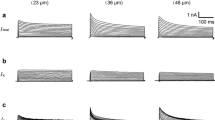We studied the desensitization kinetics of currents activated in neurons of the rat dorsal root ganglia (DRG) by short-term shifts of extracellular рН to 6.0 under conditions of primary culture using a whole-cell patch-clamp technique and intracellular perfusion. Changes of these currents under the action of ketanov were also examined. According to the decay parameters, all the observed proton-gated currents could be divided into three groups, with monoexponential fast, monoexponential slow, and biexponential desensitization kinetics. Neurons with fast monoexponential decay were divided, in turn, into two subgroups. In neurons of subgroup 1А, the decay time constant τ varied from 160 to 250 msec (n = 32), while in subgroup 1B it varied within a 250-1500 msec interval (n = 26). Neurons with the decay time constant of 1500-5000 msec formed subgroup 2A (n = 11), while cells with the longest current decay were include in subgroup 2B (t > 5000 msec, n =7). Cells of group 3, in which the currents demonstrated biexponential desensitization kinetics, had τ of the fast exponent equal to 200-600 msec (n = 21). Under conditions of application of 100 μM ketanov, the decay time constant of рН-induced currents in most DRG neurons examined decreased by 15-20%. In neurons of subgroup 2A (with decay of monoexponential currents with τ = 1500-5000 msec), currents under the action of 100 μM ketanov demonstrated not only acceleration of desensitization by 10-20%, but also a drop in the amplitude by 12‑22%.
Similar content being viewed by others
References
O. Poirot, T. Berta, J. Decosted, and S. Kellenberg, “Distinct ASIC currents are expressed in rat putative nociceptors and are modulated by nerve injury,” J. Physiol., 576, No. 1, 215–234 (2006).
O. A. Krishtal and V. I. Pidoplichko, “A receptor for protons in the membrane of sensory neurons may participate in nociception,” Neuroscience, 6, No. 12, 2599–2601 (1981).
O. I. Ostrovskaya, T. M. Volkova, and O. A. Krishtal, “Properties of proton-gated ion channels in sensory neurons of rats,” Neurophysiology, 35, No. 2, 82–89 (2003).
O. Krishtal, “The ASICs: signaling molecules? Modulators?” Trends Neurosci., 26, No. 9, 477–483 (2003).
D. Alvares de la Rosa, P. Zhang, D. Shao, et al., “Functional implications of the localization and activity of acid-sensitive channels in rat peripheral nervous system,” Proc. Natl. Acad. Sci. USA, 99, No. 4, 2326–2331 (2002).
E. Lingueglia, “Acid-sensing ion channels in sensory perception,” J. Biol. Chem., 282, 17325–17329 (2007).
T. D. Warner, F. Giuliano, I. Vojnovic, et al., “Nonsteroid drug selectivity for cyclooxygenase-1 rather than cyclooxygenase-2 are associated with human gastrointestinal toxicity: a full in vitro analysis,” Proc. Natl. Acad. Sci. USA, 96, 7563–7568 (1999).
G. A. Ushakova, N. V. Kozubenko, and Y. Y. Kobeliatsky, “Ketanov prevents changes in the level of calciumbinding protein S-100-beta under postoperation pain,” Neurophysiology, 34, Nos. 2/3, 252–254 (2002).
N. Voilley, J. Weille, J. Mamet, and M. Lazdunski, “Nonsteroid anti-inflammatory drugs inhibit both the activity and the inflammation-induced expression of acid-sensing ion channels in nociceptors,” J. Neurosci., 21, No. 20, 8026–8033 (2001).
N. Jang, K. Ran, R. Johnson, and B. Cooper, “The proton sensitivity, Ca2+ permeability and molecular basis of ASIC channels expressed in glabrous and hairy skin afferents,” J. Neurophysiol., 95, No. 1, 2–57 (2006).
P. G. Kostyuk, “Intracellular perfusion of nerve cells and its effects on membrane currents,” Physiol. Rev., 64, No. 2, 435–454 (1984).
O. P. Hamill, A. Marty, E. Neher, et al., “Improved patch-clamp techniques for high-resolution current recording from cells and cell-free membrane patches,” Pflügers Arch., 391, No. 2, 85–100 (1981).
P. Escoubas, J. De Weille, A. Lecoq, et al., “Isolation of a tarantula toxin specific for a class of proton-gated Na+ channels,” J. Biol. Chem., 275, 25116–25121 (2000).
C. J. Benson, J. Xie, J. A. Wemmie, et al., “Heteromultimers of DEG/EnaC subunit form H-gated channels in mouse sensory neurons,” Proc. Natl. Acad. Sci. USA, 99, 2338–2343 (2002).
M. Hesselager, D. Timmermann, and P. Ahring, “pH-Dependency and desensitization kinetics of heterologously expressed combinations of ASIC subunits,” J. Biol. Chem., 279, 11006–11015 (2004).
X. Jinghui, M. P. Price, A. L. Berger, and M. J. Welsh, “DRASIC contributes to pH-gated currents in large dorsal root ganglion sensory neurons by forming heteromultimeric channels,” J. Neurophysiol., 87, 2835–2843 (2002).
C. Chen, S. England, A. Akopian, and J. Wood, “A sensory neuron-specific, proton-gated ion channel,” Proc. Natl. Acad. Sci. USA, 95, 10240–10245 (1998).
E. Bassler, T. Ngo-Anh, H. Geisler, et al., “Molecular and functional characterization of acid-sensing ion channel (ASIC) 1b,” J. Biol. Chem., 276, 33782–33787 (2001).
K. Babinski, S. Catarsi, G. Biagini, and P. Séguéla, “Mammalian ASIC2a and ASIC3 subunits co-assemble into heteromeric proton-gated channels sensitive to Gd3+,” J. Biol. Chem., 275, 28519–28525 (2000).
S. Sutherland, C. Benson, J. Adelman, and E. McCleskey, “Acid-sensing ion channel 3 matches the acid-gated current in cardiac ischemia-sensing neurons,” Proc. Natl. Acad. Sci. USA, 98, 711–716 (2001).
J. Yagi, H. Wenk, L. Naves, and E. McCleskey, “Sustained currents through ASIC3 ion channels at the modest pH changes that occur during myocardial ischemia,” Circ. Res., 99, 501–509 (2006).
R. Waldmann, F. Bassilana, J. De Weille, et al., “Molecular cloning of a non-inactivating proton-gated Na+ channel specific for sensory neurons,” J. Biol. Chem., 272, 20975–20978 (1997).
T. Walters, M. Raizman, P. Ernest, et al., “In vivo pharmacokinetics and in vitro pharmacodynamics of nepafenac, amfenac, ketorolac and bromfenac,” J. Cataract Refract. Surg., 33, No. 9, 1539–1545 (2007).
D. Bustamantea and C. Paeile, “Ketorolac tromethamine: An experimental study of its analgesic effects in the rat,” Gen. J. Pharmacol., 24, No. 3, 693–698 (1993).
Author information
Authors and Affiliations
Corresponding author
Rights and permissions
About this article
Cite this article
Petrushenko, E.A. Proton-Gated Ion Currents in Neurons of the Rat Spinal Ganglia and the Action of Ketanov on These Currents. Neurophysiology 45, 6–12 (2013). https://doi.org/10.1007/s11062-013-9330-4
Received:
Published:
Issue Date:
DOI: https://doi.org/10.1007/s11062-013-9330-4



